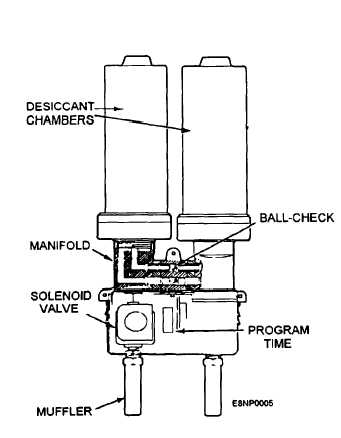sealed dome and the outlet line fluid. When outlet line
pressure drops below dome pressure, the diaphragm
moves out slightly and pushes the main valve open.
This allows inlet line gas to flow through the valve until
outlet line pressure builds up enough to balance the
dome pressure. Then, the diaphragm moves back to
throttle or closes the main valve so that dome and outlet
pressures always remain in balance.
Any change in dome pressure causes a
corresponding change in outlet line pressure. When the
dome is completely vented, the main valve shuts off
bubble tight.
Any trouble with the pressure regulator can usually
be traced to the valve and valve seat, or to the diaphragm
and O-rings being worn or deteriorated.
Dehydrator
The dehydrator (fig. 2-5) consists of two desiccant
chambers filled with desiccant in the form of small
spheres. The desiccant chambers are supported by the
manifold, and they are connected to the manifold by
internal air passages. A pair of two-way solenoid valves
are attached to the bottom side of the manifold.
The program timer controls the operation of the two
solenoid valves. In one 60-second period, each solenoid
valve is open for 22 seconds and closed for 38 seconds.
The timing for the solenoid valves is such that both
valves are closed for two 8-second dwell phases. One
complete cycle takes place in each desiccant chamber
every 60 seconds.
Dry air is needed for reactivation of the desiccant
chambers. A small quantity of dry air (figs. 2-5 and 2-6,
phase I) is bypassed around the ball-check valve by a
Figure 2-5.—Dehydrator.
Figure 2-6.—Dehydrator operating cycle.
2-7




